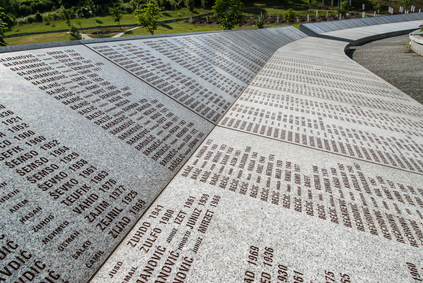‘How could you do this, Karadzic?’ asks Srebrenica mother

Munira Subasic, president of the ‘Mothers of Srebrenica’, will be in court when former Bosnian Serb leader Radovan Karadzic hears his verdict at the International Criminal Tribunal for the former Yugoslavia (ICTY), writes Jesse Wieten.
‘This will be an historic judgment for both the victims and Bosnia and Herzegovina,’ Subasic said in an interview with Dutchnews.nl.
Munira Subasic lost 22 relatives in the massacre at Srebrenica in July 1995, including her husband and son. During the Bosnian war the ‘safe haven’ in Srebrenica was protected by Dutch soldiers under the UN flag. Over 8,000 men and boys were murdered and buried in mass graves when the enclave was over-run by Bosnian Serb forces, in what was Europe’s worst atrocity since World War II.
‘At the beginning of the war I could not and did not believe that it would happen,’ Subasic said. ‘I could not believe that our neighbours would turn their backs on us and that they would turn into perpetrators. I could not believe that teachers would turn against their students, raping and killing them.
‘The situation in Srebrenica and, I am sure, everywhere else in Bosnia and Herzegovina, was unimaginable. It is hard to explain what I saw and heard. I saw people getting killed and dying because of hunger. I heard cries and screams. It was unbearable.’
11 counts
The genocide in Srebrenica is one the 11 counts against former Bosnian Serb political leader Karadzic. ‘I hold Karadzic personally responsible for the loss of our loved ones,’ Subasic said.
‘He was the alpha and omega of the war of aggression in Bosnia and Herzegovina, who ordered the killings of innocent people just because he thought they were different and unworthy. He was the one who ordered who would live and who would be killed.’
‘Karadzic ordered and Ratko Mladic killed with his army,’ Subasic added. ‘They tortured and raped innocent civilians and Karadzic could have stopped it if he wanted to.’
Mothers
One year after the massacre in Srebrenica relatives established the movement of ‘Mothers of Srebrenica and Zepa Enclaves’ with an office in Sarajevo and a centre in Srebrenica. The mission of the organisation was to gather more survivors and family members of the victims who had disappeared or been killed in Srebrenica, Zepa and other regions, and to learn more about the fate of those killed or who had disappeared. Subasic became the president of this association.
‘Our actions are important,’ she said. ‘What happened in the past cannot be changed but we can learn from the past so that our grandchildren can live in a better and more prosperous, peaceful Bosnia and Herzegovina.’
‘Over the past 20 years, we have given our utmost to seek truth and justice,’ Subasic continued. ‘We have tirelessly worked on making sure that there is a memorial centre in Srebrenica-Potocari. We have been and still are witnesses at ongoing trials. We have and still are working with children whose parents were killed. All of our efforts have been and still are to make sure that the past is not forgotten and that future generations will learn from the past.’
Arrest
As president of the association, Subasic visited the ICTY in The Hague many times and she has seen many war crimes suspects in court over the past years. Her relief was immense when Karadzic was arrested in 2008 and he was transferred to the Tribunal’s custody.
‘I feared that the political apparatus would prevent Karadzic’s arrest,’ she said. ‘Nevertheless, with the changes in international politics, he was arrested. I would say that he was arrested when Europe wanted him to be arrested.’
‘I have seen Karadzic in the court room and I despised him,’ Subasic added. ‘I still cannot believe that in the 21st century, a doctor, in Karadzic’s case a psychologist, would commit the crimes that he has committed. I asked myself how and why? How could he do it? I hope he will get life imprisonment, not only for the genocide in Srebrenica but for all of the municipalities in Bosnia and Herzegovina where genocide was committed.’
Subasic’s husband Hilmo was identified and buried in 2004 while the remains of her son Nermin were only found in 2013. Their remains were found in two different mass graves 25 kilometers apart from one another.
Two small bones
‘I gave birth to a healthy baby boy who grew up to be a handsome young man,’ Subasic said. ‘Now, I have only buried two small bones belonging to him. Among the approximately 6,500 graves, his grave has the least and smallest bones or remains buried.
‘I have a grave for both of them and their graves have their names on them. That means a lot to me as it would to any mother. This is proof that they lived and that they were loved. They have not been erased. This is why it is important to find every single victim, they deserve to have their names known and engraved.’
Despite the seeking for justice, the seeking for the truth, the travelling to face the likes of Karadzic, her grief will never fade away. ‘I last saw my son in Srebrenica before they took him away from me,’ Subasic said. ‘Now, as I am in my 70s, I am alive but I am not living, and the greatest injustice is waiting for justice.’
Thank you for donating to DutchNews.nl.
We could not provide the Dutch News service, and keep it free of charge, without the generous support of our readers. Your donations allow us to report on issues you tell us matter, and provide you with a summary of the most important Dutch news each day.
Make a donation